Want to know what the best, healthy alternative for rice for weight loss is?
Today, you learn why rice isn’t great for your health and the 13 most filling and best substitutes for rice for boosting your metabolism.
Want to learn more? Read on!
Go directly to the alternatives:
What is a healthy substitute for rice?
Are there any healthy substitutes for rice? Today, we’ll look at the best alternatives for rice for weight loss.
Is there any rice that is good for you?
Is white rice healthy?
Many view it as an unhealthy option, and I tend to agree. It’s highly processed and lacks many nutrients. Its hull (hard protective coating), bran (outer layer), and germ (nutrient-rich core) are missing and only the endosperm, which is carbohydrate-rich, is left intact.
That said, white rice is often enriched with nutrients like B vitamins and iron. But this is a fraction of the naturally occurring nutrients.
Studies also show that refined grains, including rice, are not as filling as whole grains and aren’t beneficial for weight loss.
But there’s no clear consensus on how bad white rice is for weight loss. Some research indicates that diets high in refined grains lead to weight gain, obesity, and belly fat. Other research refutes this. And other research, again, indicates that white rice, especially in countries where it’s an everyday food, promotes weight loss.
That said, there is more consistent research that shows that alternatives to white rice, like brown rice, are better for weight loss (see this study and this study).
Research also shows that eating white rice regularly can raise the risk for type 2 diabetes. A review of over 350,000 people indicates that people who ate the most white rice were at a higher risk of getting type 2 diabetes, compared to those who ate the least.
On the other hand, white rice is naturally gluten-free, so for people with celiac disease or gluten sensitivity, they’re a good carb option.
What can I replace white rice with?
So, what can you substitute white rice with? Great question. Fortunately, there are several excellent options such as quinoa, couscous, broccoli rice, and more. These foods are high in nutrients and work well for weight loss and improving your overall health.
What is the best alternative for rice for weight loss?
First, up: quinoa. I will then share 12 more alternatives for rice. They’re all flavorful and work well with protein like chickpeas and salmon (a must for weight loss).
1. Quinoa
Quinoa is an edible seed that’s high in manganese, phosphorus, magnesium, folate, and vitamin B1.
At the same time, quinoa is classified as a whole grain and it’s a good source of complete plant protein (it contains all nine essential amino acids) and fiber. One cup of quinoa contains 8 grams of protein and 5 grams of fiber. Plus, quinoa is an excellent source for people with gluten intolerance, as it’s naturally gluten-free.
Vitamin B1 and protein boost metabolism and magnesium supports healthy digestion. What’s more, the antioxidants and other nutritious attributes help weight loss.
Quinoa is a great alternative for rice for weight loss because protein digests more slowly and keeps you fuller for longer. Fiber improves digestion, which deflates bloating, and adds bulk to your meal without calories.
Although quinoa does have carbs, it’s not as many as rice. And the other benefits like high fiber and protein make it a slower burning carb.
2. Couscous
A proper grain alternative for rice for weight loss, couscous is low in carbs, and rich in protein and fiber.
Fun fact:
It actually has fewer calories than both rice and quinoa. It’s not, however, gluten-free.
One of the biggest reasons I love couscous for weight loss is protein content. It’s a spectacular source of plant-based protein for everyone, but especially for those who don’t eat meat.
Getting enough lean protein will help you stay full and keep your blood sugar levels stable throughout the day. That way you won’t be tempted by the mid-afternoon junk food pangs.
One cup of couscous contains 6 grams of protein. However, note that couscous doesn’t contain all amino acids to be considered a complete protein. Combine it with other plant or animal proteins to ensure that you get all essential amino acids.
Couscous also contains plenty of selenium. One cup of couscous contains more than 60% of the recommended daily intake.
Selenium decreases inflammation and helps your body repair damaged cells, which, again, boosts your immunity. It’s also important for a properly working thyroid gland. Finally, selenium can help reduce bad LDL cholesterol and lower your risk of heart disease.
Because it’s rich in nutrients, couscous is a far better alternative than white rice. Just note that it doesn’t contain enough fiber (quinoa and brown rice are better sources for fiber) or potassium (which you find in foods like avocados).
3. Cauliflower rice
Cauliflower is a rich source of fiber and vitamin C. Vitamin C helps your body use fat cells as a fuel source and burn them away.
Cauliflower rice is simply “riced” or finely crumbled real cauliflower florets. Although it’s not quite as filling as grains, cauliflower rice does fill up a plate nicely and add fluffy texture to your food, and it visually resembles rice which makes it an easy transition.
It’s easy to buy it premade and frozen from Green Giant at most grocery stores in the freezer aisle.
Plus, since it’s a vegetable, you can always add another scoop and still be eating way fewer calories and carbs with lots of benefits.
You can also make cauliflower rice at home pretty easily like with this recipe from Downshiftology.
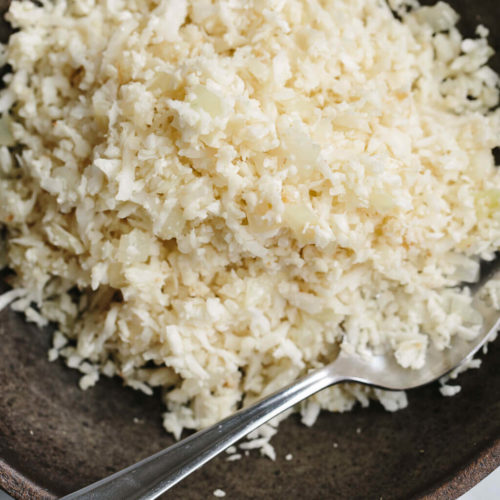
Cauliflower Rice
Ingredients
- 1 head cauliflower washed
- 1/2 yellow onion, diced
- 2 tablespoons olive oil
- Salt and pepper, to taste
Instructions
- Slice the cauliflower head in half and use a knife to remove all the florets. Cut some of the larger florets into smaller pieces so they'll fit within the chute of your food processor.
- Insert the grater adapter into your food processor and start feeding the cauliflower florets through the top. Depending on the size of your food processor, you may have to empty it halfway through.
- Heat the olive oil in a large pan and sauté the diced onion for a few minutes, until its translucent.
- Add the cauliflower rice to the pan and sauté for another 5-7 minutes.
- Season with salt and pepper and serve immediately.
4. Broccoli rice
While riced cauliflower has a slightly milder taste and is white like regular rice, broccoli rice might need a little getting used to because it’s green and tastes like, well broccoli!
It’s still nice for adding that fluffy, bulky texture to a creamy meal, and it has so many health benefits that it’s totally worth giving it a shot.
You can find this premade and frozen from Green Giant in the freezer aisle at most grocery stores.
Broccoli is a weight-loss star because of its high vitamin C, calcium, and Sulforaphane. You already know what vitamin C does for weight loss. Sulforaphane is a phytochemical that helps fight cancer and trigger the breakdown of fat cells.
Broccoli also contains iron, potassium, selenium, fiber, protein, magnesium, vitamins A, C, E, K, and B.
Regular consumption of steamed broccoli can lower the risk of cardiovascular disease as it lowers the amount of cholesterol. Broccoli might also reduce the risk of heart disease.
More research is needed, but it seems that vitamin K improves bone health and increases mineral density.
As an alternative to rice, broccoli is best eaten boiled or steamed to preserve its antioxidant status. Cooking broccoli can destroy vitamin C.
5. Brown rice
Is brown rice better than white rice?
Brown rice doesn’t go through the same milling process as white rice and so it keeps more of its nutrients (which are artificially added to white rice). However, both white and brown rice are high in carbohydrates.
Brown rice is a whole grain, which white rice isn’t. Whole-grain foods can help lower the risk of heart disease, type 2 diabetes, and stroke.
Whole grain varieties of rice, like brown rice, are rich in fiber, vitamin B1, magnesium, manganese, selenium, and phosphorus. Brown rice includes more of these nutrients than white rice.
For weight loss, brown rice is better than refined alternatives like white rice because brown rice is more nutritious.
For example, brown rice contains 3.5 grams of fiber per cup. White rice only contains less than 1 gram.
As research shows, fiber helps you feel fuller over a longer period of time. This can help you consume less food and calories, which again helps you lose weight.
A study of over 74,000 women shows that the women who ate more whole grains and fiber tended to weigh less than those who didn’t eat as many whole grains.
In another study, 40 overweight women ate ⅔ cups of brown rice every day for six weeks. Their waistline was significantly reduced compared to women who ate white rice.
All in all, if you do decide to eat rice, brown rice is a much better option than white rice, both in terms of its overall health benefits and for losing weight.
6. Barley
The next alternative for rice? Barley!
You see, barley, as a whole grain, is rich in vitamins, minerals, fiber, manganese, selenium, molybdenum, copper, vitamin B1, chromium, phosphorus, magnesium, and niacin.
Barley is an excellent alternative for rice for weight loss. Thanks to being high in fiber and especially soluble fiber, barley makes you feel fuller for longer. Soluble fibers slow digestion and absorption of nutrients so that you stop feeling hungry.
Also, if you have metabolic disease, soluble fiber can help reduce belly fat. Metabolic disease means that your metabolism isn’t working properly. Up to one-third of US adults have this condition.
Just note that to enjoy these health benefits, you need to eat unrefined, whole-grain barley. Pearl barley is refined and doesn’t contain all these nutrients.
Also, if you’re on the Paleo diet, barley might not be the best option for you. You see, it’s not allowed as part of this diet.
7. Chopped cabbage
Cabbage is a great alternative to white rice. You can chop it up or cook it. Alternatively, eat fermented cabbage in the form of sauerkraut or kimchi. Fermented foods have an added health benefit; they improve gut microbiome, which strengthens the walls of your intestines.
Cabbage doesn’t contain many calories, but instead, it contains plenty of nutrients. Cabbage contains protein, fiber, vitamin K, B6 and C, folate, manganese, calcium, fiber, potassium, and magnesium.
This vegetable is good for your stomach, because it contains insoluble fiber. This type of fiber can’t be broken down in the intestines and it helps keep the digestive system healthy by adding more bulk to stool.
It also contains soluble fiber, which, just like barley, makes you feel fuller.
Soluble fiber and another nutrient found in cabbage, plant sterols, have been shown to reduce unhealthy levels of LDL cholesterol.
What’s more, cabbage has a range of other benefits. It contains antioxidants that can reduce chronic inflammation. Plus, thanks to vitamin C, cabbage can help bones, muscles, and blood vessels function better, as well as improve the elasticity of your skin.
Red cabbage contains anthocyanins, which have been linked to a reduced risk of heart disease.
Cabbage, especially red cabbage, might lower your blood pressure. It’s high in potassium, which has been shown to improve blood pressure levels.
8. Bulgur wheat
Bulgur wheat is a high-fiber whole grain. Just one cup of cooked bulgur contains over 30% of the recommended daily intake of fiber.
Bulgur also contains manganese, magnesium, and iron.
Because bulgur is so rich in fiber, it’s a great food to eat if you want to lose weight. As we’ve established here above, fiber makes you feel fuller than many other foods.
Bulgur may also have other health benefits. It’s rich in phytonutrients, which may play a role in the prevention of diabetes and other diseases.
Plus, bulgur might be good for your gut by promoting gut bacteria that support digestive functioning and intestinal health.
And as a whole grain rich in fiber, bulgur can be beneficial for heart health. Fiber might lower both blood pressure and cholesterol and, that way, prevent heart disease.
On the downside, bulgur is not a gluten-free option. Also, its insoluble fiber can make it hard to tolerate for people with inflammatory bowel disorder and irritable bowel syndrome.
In other words:
If you don’t have intolerances, bulgur can be a great way to add fiber to your plate (and way better than refined white rice, with 0g fiber).
Next:
Shirataki rice!
9. Shirataki rice
Shirataki is made from glucomannan, a fiber from the konjac plant. 3% glucomannan flour is mixed with 97% water and lime water (so that it keeps its shape). It’s not at all difficult to prepare- all you have to do is rinse the rice and then saute the dry rice for about 10 minutes. Season according to taste. (Here are step-by-step instructions.)
Shirataki is also sold as noodles. There is no major difference between shirataki rice and noodles.
Shirataki is popular as a keto alternative to rice. You can buy it at most grocery stores. For example, Walmart stocks the shirataki rice brand Miracle Rice.
But what are the benefits of shirataki compared to white rice?
There is some scientific evidence that glucomannan may be beneficial for weight loss, though there aren’t many studies on the topic.
Why? Shirataki doesn’t contain digestible carbs and it’s low in calories. It’s also rich in a type of soluble fiber, which makes you feel fuller. It moves slowly through your body, keeping you satisfied for longer.
Plus, the fiber in glucomannan can help fight inflammation and boost immune function thanks to nourishing bacteria in your gut.
What’s more, research shows that glucomannan helps to lower blood sugar levels in people who suffer from diabetes and insulin resistance.
Other research indicates that glucomannan can lower cholesterol levels and treat constipation.
10. Farro
Farro is a grain that looks like brown rice. Just like rice, you cook farro in water until it becomes soft.
It’s full of fiber, vitamins, zinc, magnesium, antioxidants, and protein. The word “farro” actually refers to three different grains: einkorn, spelt, and emmer.
One of the main benefits of farro is that one cup of it contains 20% of your daily recommended fiber intake.
As we’ve seen before, fiber can help prevent heart disease and lower the risk of developing type 2 diabetes. It also improves gut health and prevents constipation. Fiber makes you feel fuller for longer, which can impact how much you eat in a day.
Farro also contains a lot of protein (24g per cup). By combining farro with other protein sources like legumes, you get enough amino acids.
Protein is also important for reducing hunger feelings and gaining muscle mass.
Finally, farro has a low glycemic index. You digest it more slowly and as a result, your blood sugar levels don’t rise too fast, which helps prevent cravings.
All in all, farro is a much better alternative than white rice. However, gluten-sensitive people shouldn’t necessarily eat it because it’s wheat.
Farro is sold as whole-grain farro, pearled, and semi-pearled. Whole-grain farro is the healthiest alternative, as it contains the most nutrients and fiber.
11. Lentils
Lentils are part of the legume family. They’re edible seeds and they come in various colors and forms. The most common types are brown, yellow, red, green, beluga, and puy lentils.
Every type of lentil has its own composition of antioxidants and phytochemicals. They’re full of magnesium, B vitamins, zinc, iron, fiber and potassium. What’s more, lentils contain over 25% protein, so they’re an excellent source of protein for vegetarians and vegans.
The polyphenols in lentils have strong antioxidant, neuroprotective, and anti-inflammatory effects. They may in some cases be able to stop cancer cell growth and improve blood sugar levels.
Lentils can also lower the risk of heart disease. And thanks to fiber and protein, lentils may help you feel fuller for longer so that you eat less (while feeling satisfied) and lose weight.
However, lentils contain some antinutrients, which can prevent the absorption of other nutrients. Dehulling and cooking lentils reduces the number of them.
All in all, lentils are a great and nutritious substitute for rice. They can be used in salads or as a side dish, just like rice. Feeling inspired? Here’s one of my favorite lentil soup recipes!
12. Beans
Beans are a great source of protein, fiber, iron, and B vitamins. They’re also a varied substitute for rice. You can eat them on the side or use them in salads or soups. Plus, there are various beans with their own health benefits and tastes.
Some of my favorites are black beans, kidney beans, pinto beans, red beans, garbanzo beans, and navy beans.
Beans don’t contain all amino acids, which is why you want to combine them with a different source of protein, such as couscous.
And they also contain a lot of other healthy nutrients. Even half a cup of black beans contains 14g of fiber or over half of the daily requirement for fiber.
Because beans are high in fiber, they help regulate hunger feelings and cravings and reduce the spike in blood sugar that occurs after a meal.
Beans may help lower the risk of coronary heart disease and lower cholesterol. They can also improve your gut health and prevent gut diseases.
Here’s my tasty garbanzo bean recipe to get you started.
13. Zucchini rice
Zucchini can quickly be made into a healthy substitute for rice. Simply spiralize zucchini and add it to a food processor. You can cook your zucchini rice or season it and serve it cold, according to taste.
Zucchini contains protein, carbs, vitamin A (40% of the recommended daily intake), manganese, vitamin K, vitamin C, folate, copper, phosphorus, vitamin B6, iron, calcium, zinc and thiamine.
It’s also rich in antioxidants, which can be beneficial for your skin, eyes, and heart. Also, thanks to insoluble fiber, zucchini can help prevent constipation. And soluble fiber nourishes healthy gut bacteria. A specific type of soluble fiber, percin, helps reduce bad LDL cholesterol levels.
Zucchini can help lower blood sugar and insulin levels, which is beneficial for those with type 2 diabetes. And thanks to being high in fiber, it may lower the risk of heart disease.
Thanks to vitamin C and beta-carotene, zucchini can help improve your vision.
And because it’s rich in water and fiber, it can help you feel fuller for longer. Eating lots of vegetables is linked to a lower rate of weight gain over time.
Over to you!
There you have it! Now you know what the 13 best alternatives for rice for weight loss are.
What it comes down to is using unrefined, whole-grain alternatives and eating a mixed diet so that you get all the needed nutrients.
Which of these alternatives is your favorite?
Let me know in the comments below!
Reviewed by: Diana Gariglio-Clelland (RD, BSc)
Register now for my training, The 5-Step Game Plan to Lose 20-40 Pounds for professional women, physicians, and entrepreneurs!
You’ll learn:
- The step-by-step game plan our corporate executive clients use to lose two to three dress sizes
- The real reason why cardio and exercise is NOT a good strategy to slim down
- How our clients STOP feeling frustrated, guilty and unsure about what they’re eating

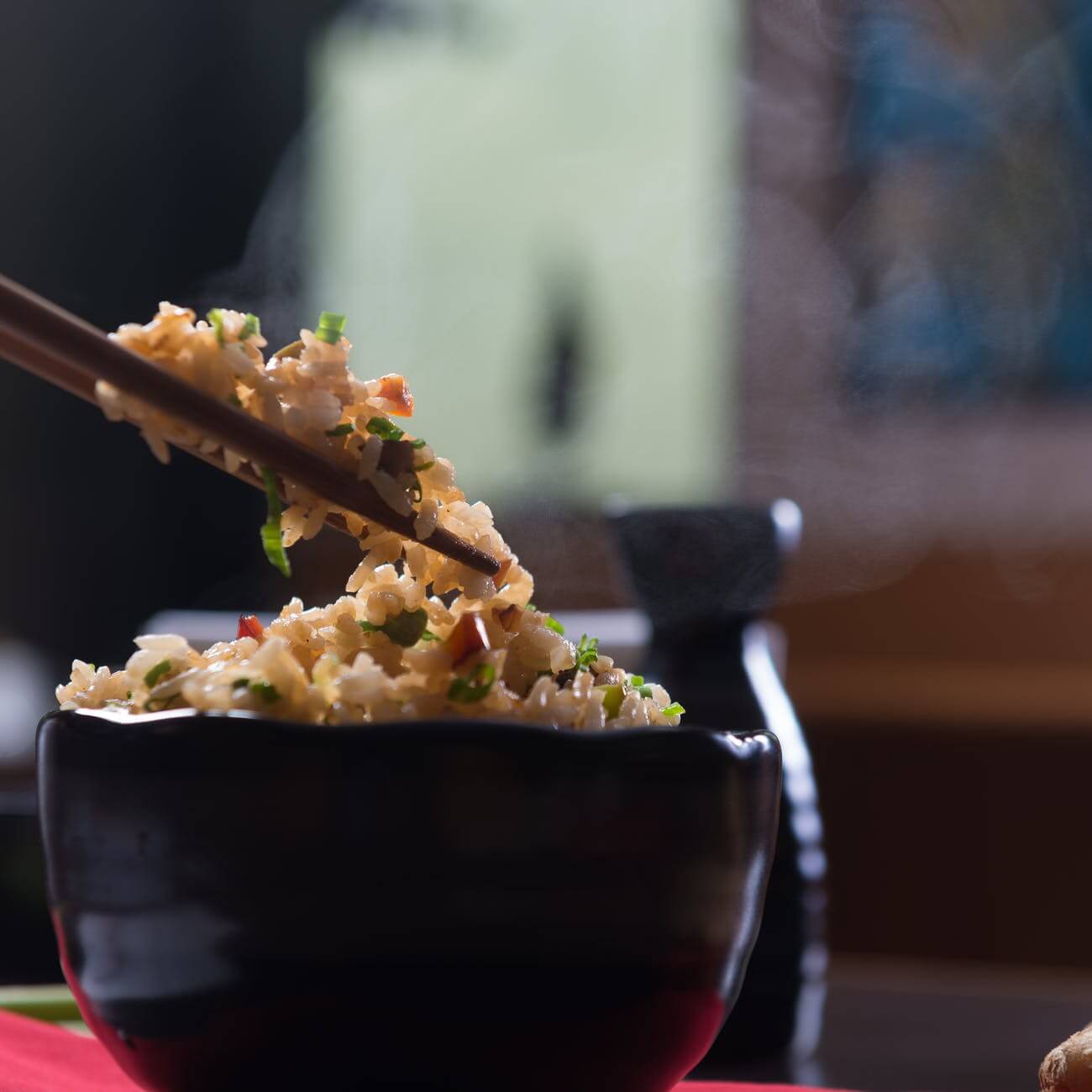
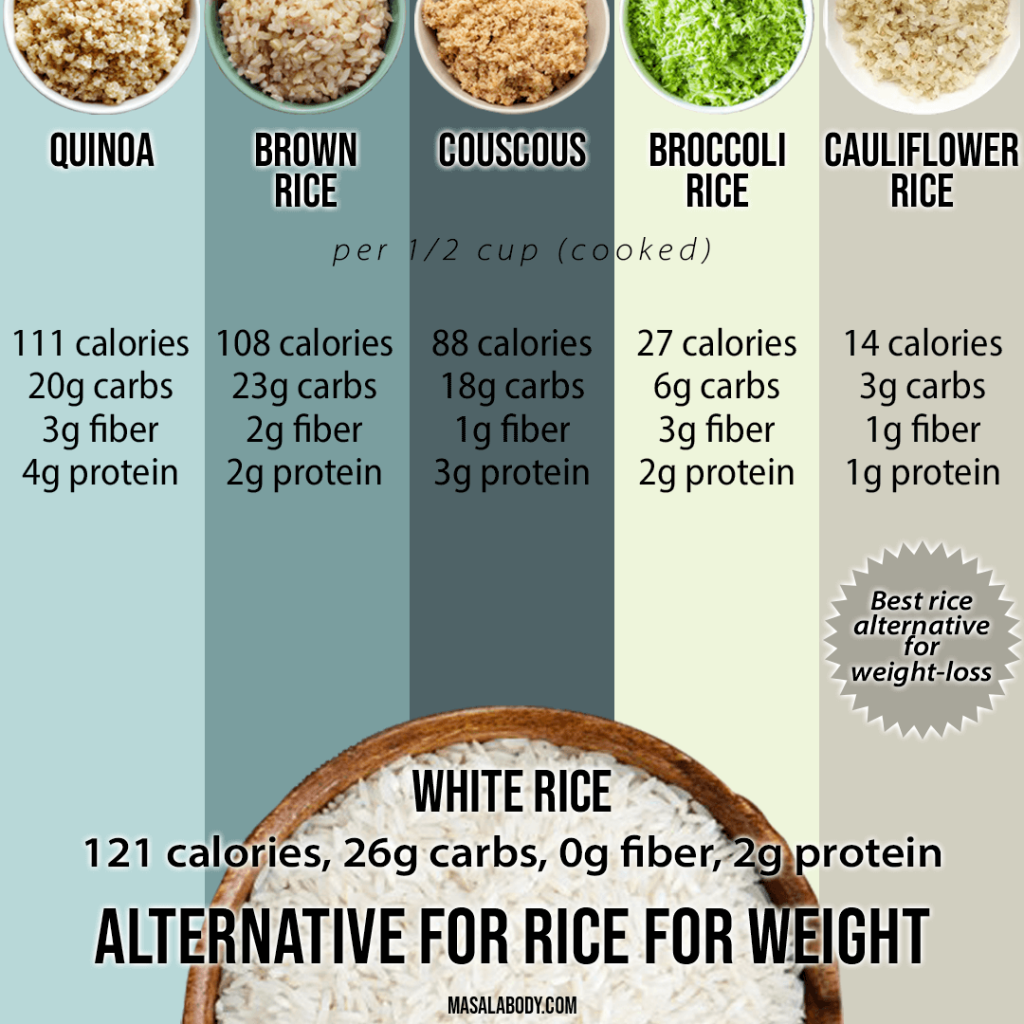

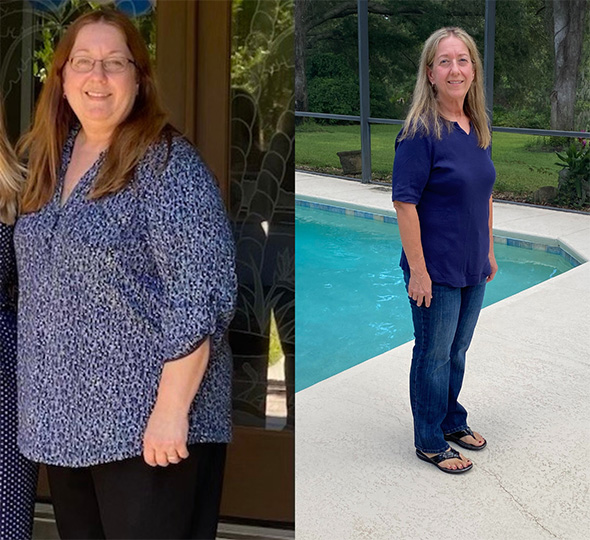
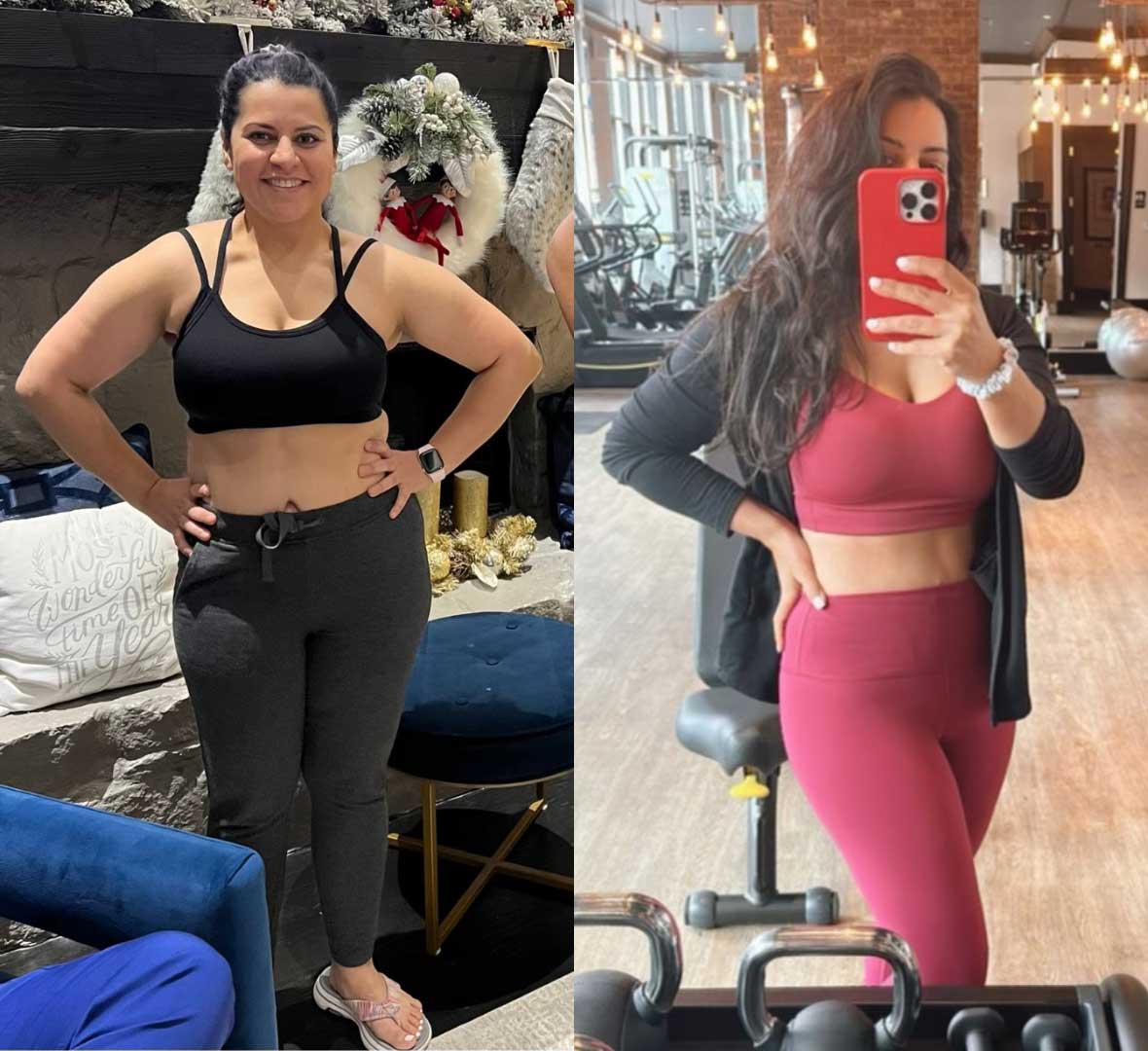

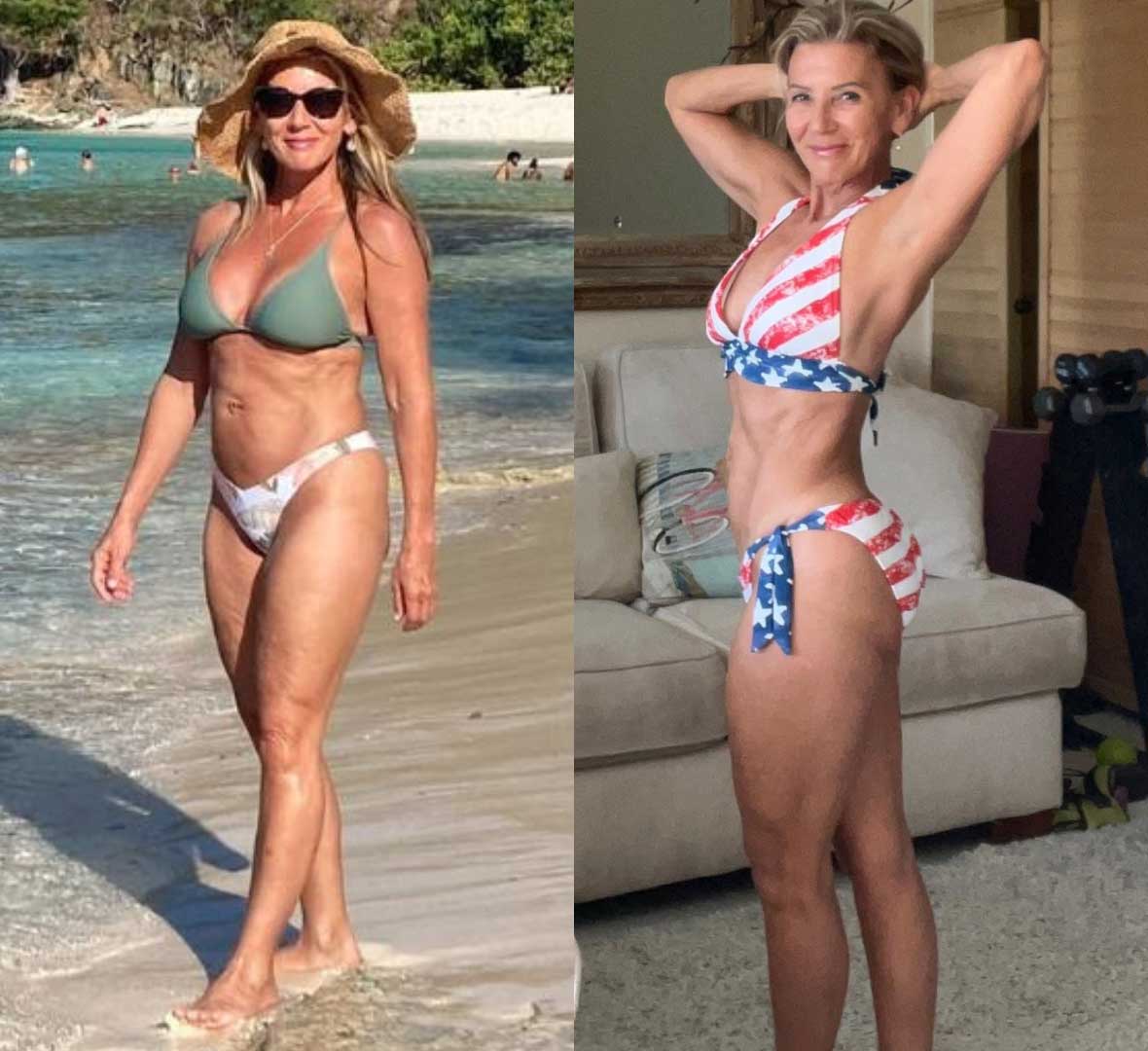


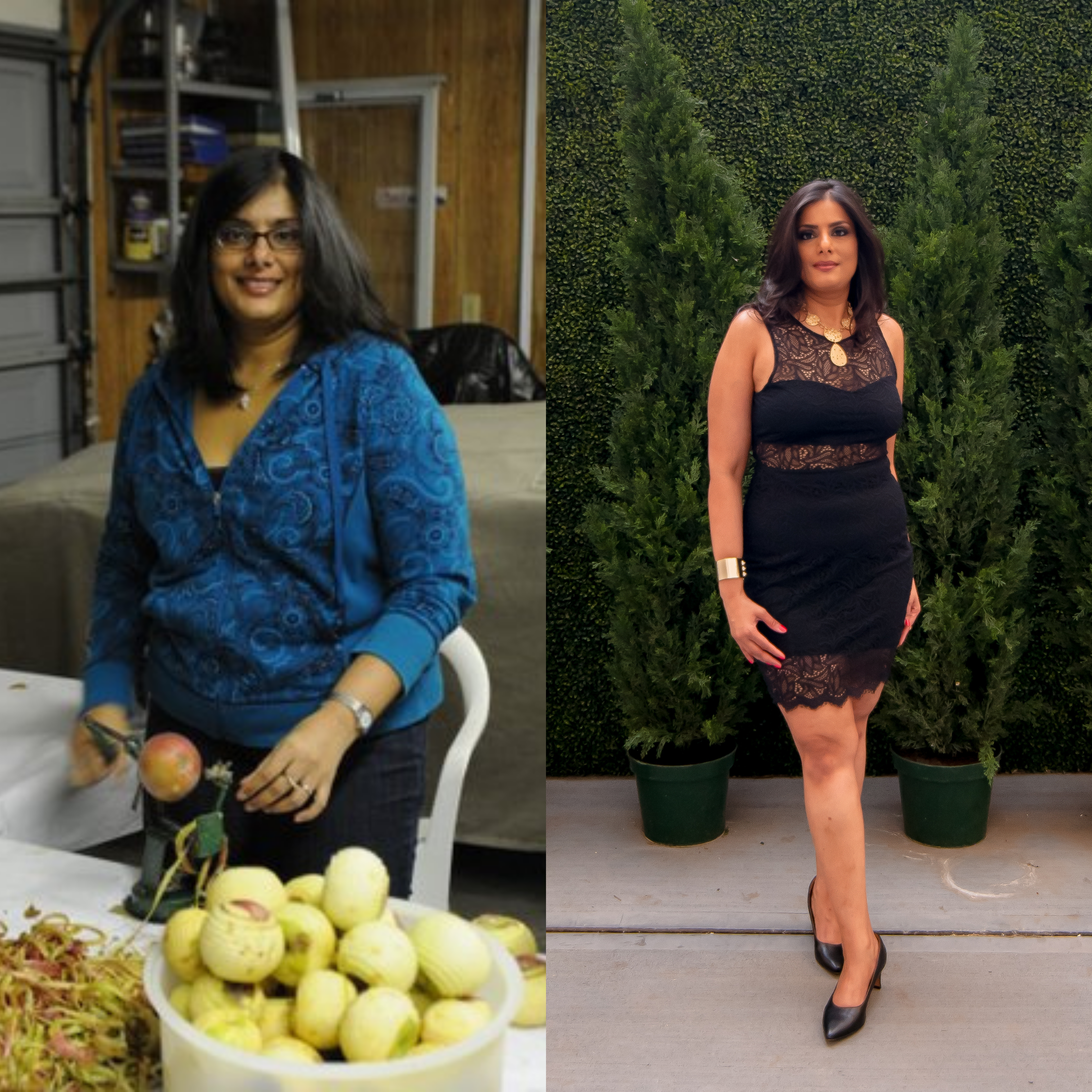




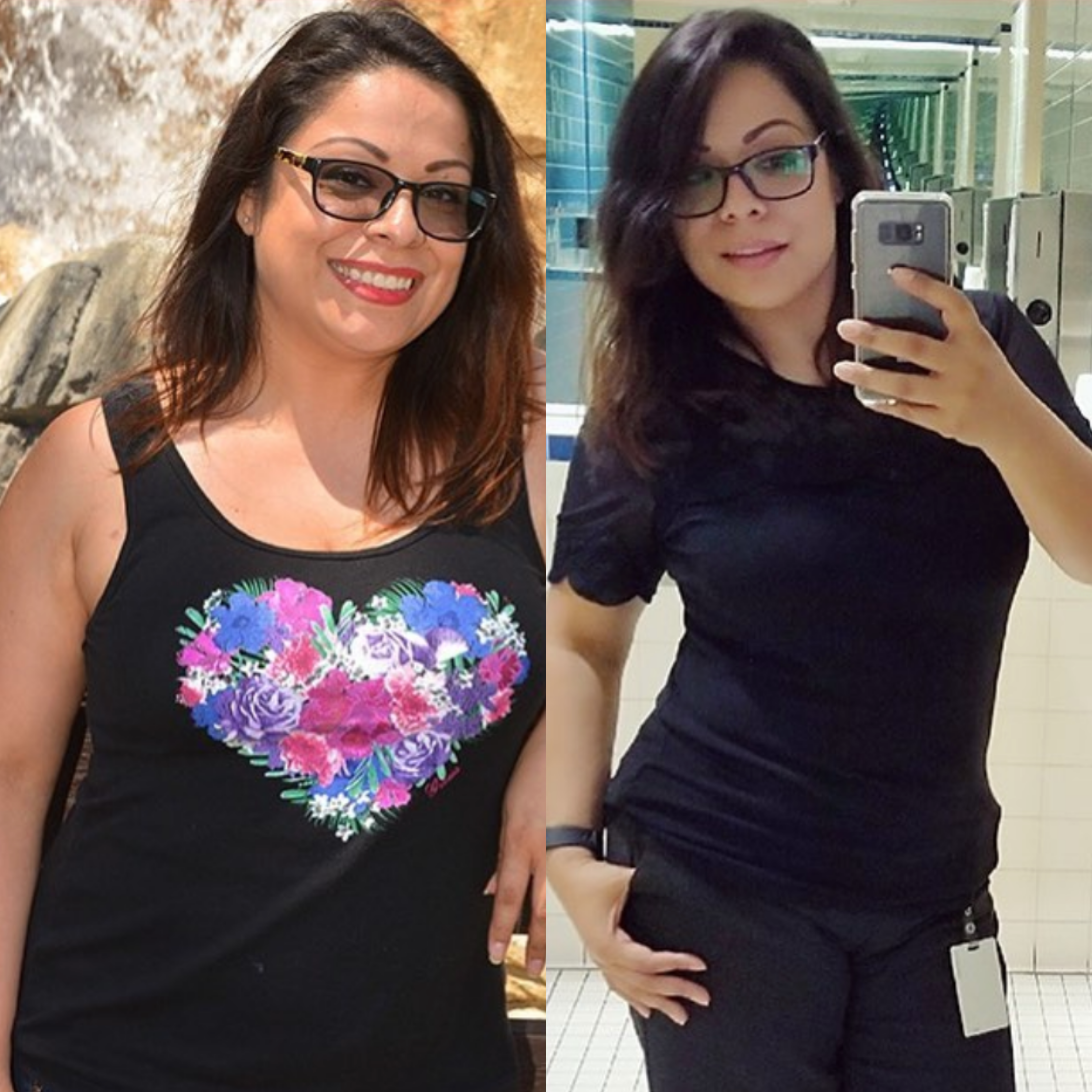






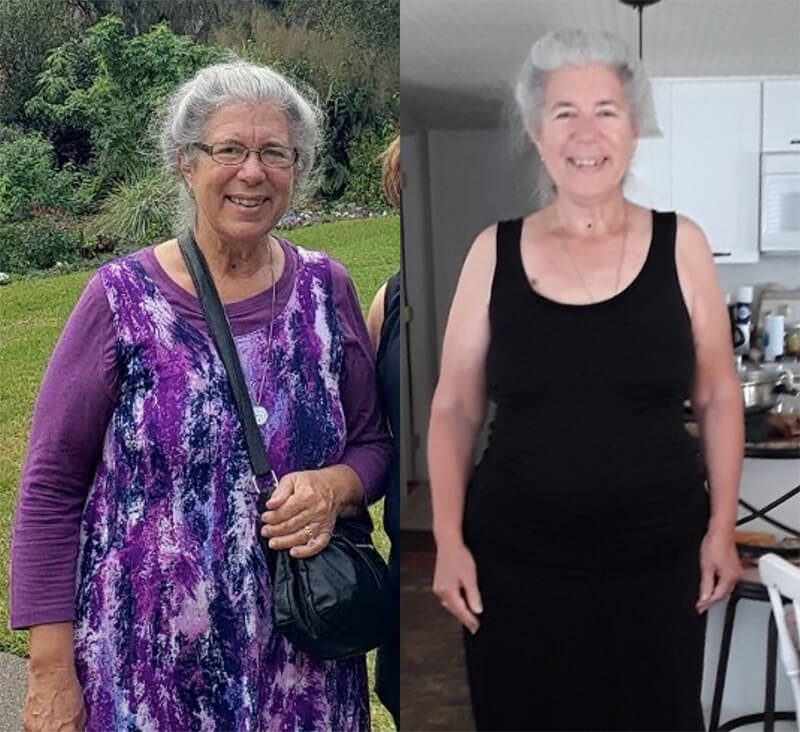



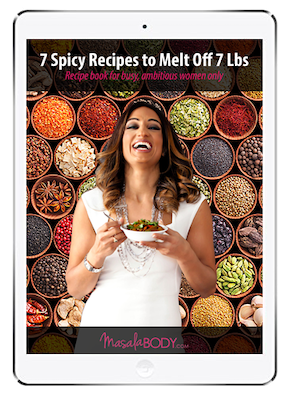
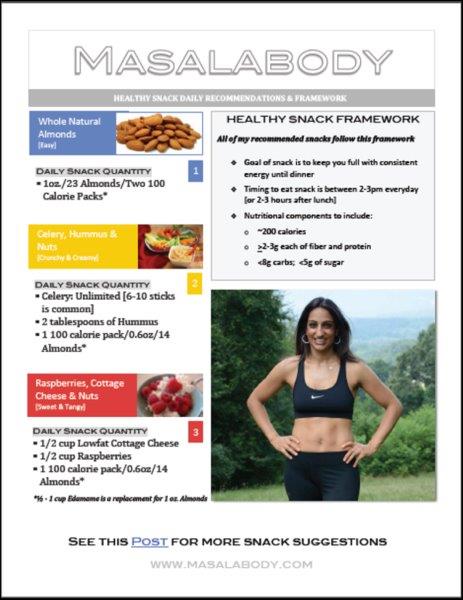

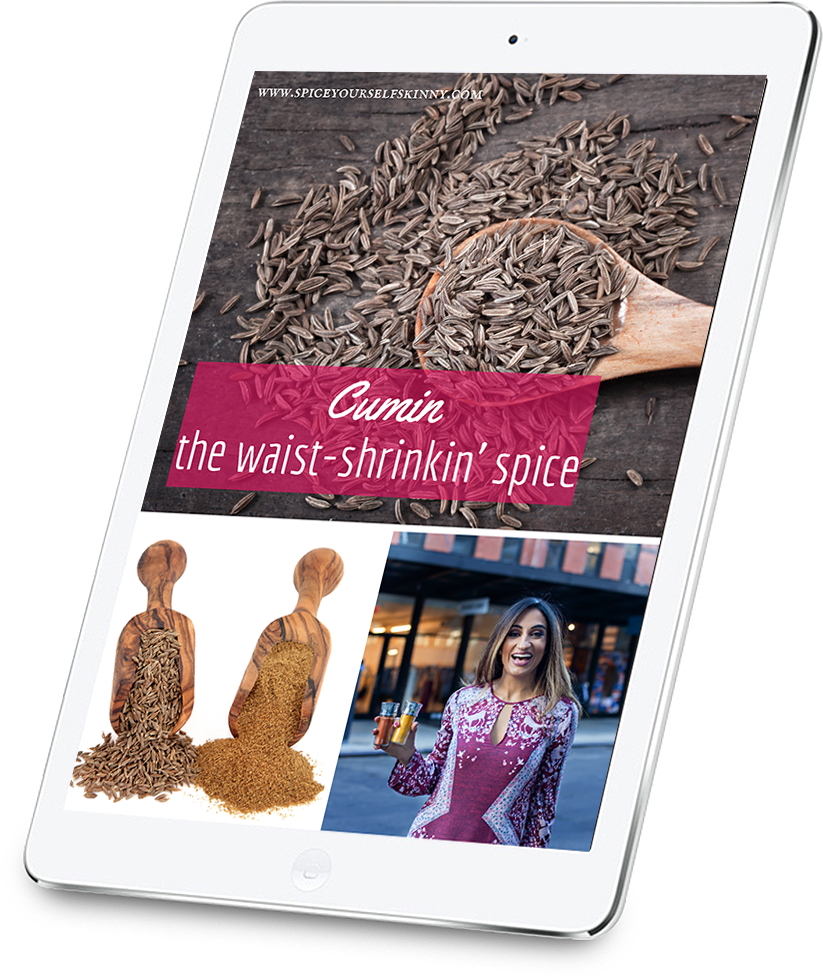
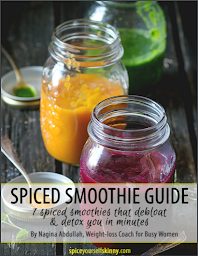
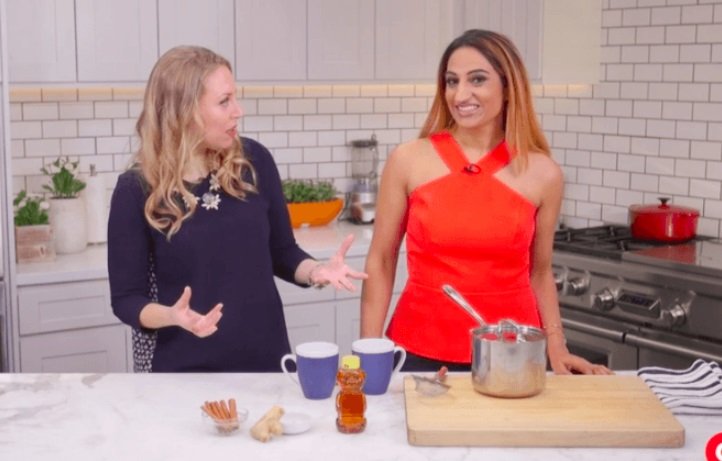

Reader Interactions